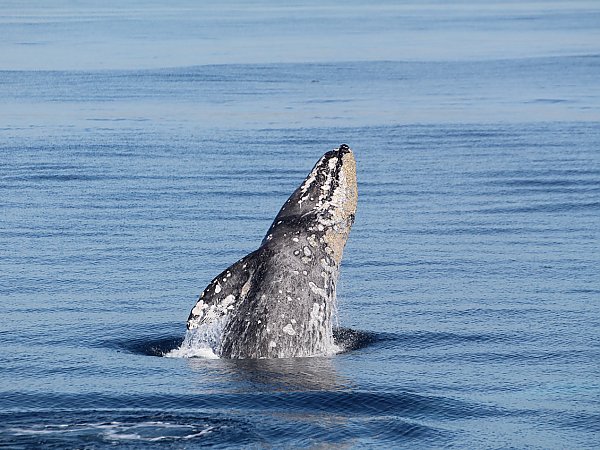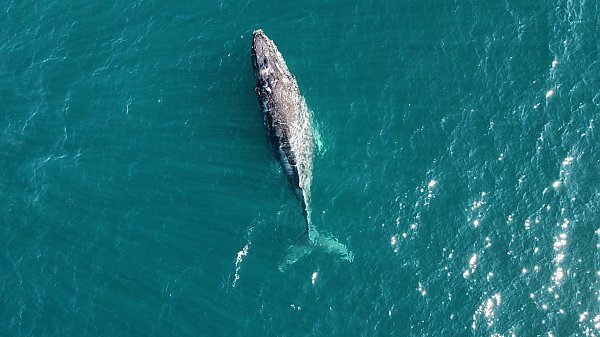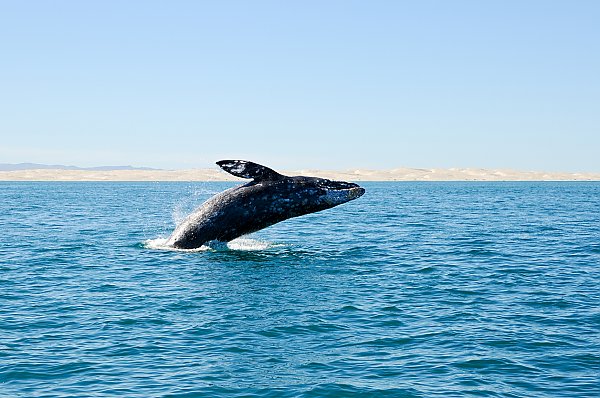Eastern North Pacific Gray Whale
Eschrichtius robustus
Eastern North Pacific Gray Whale
Eschrichtius robustus
The recovery of the Eastern North Pacific gray whale from near extinction is one of conservation’s greatest success stories.
Morphology
The Eastern North Pacific Gray Whale (Eschrichtius robustus) is a baleen whale, so-named because they use 300 to 400 pairs of keratin plates that are located in their upper jaw for filter feeding; these structures are called “baleen plates”. Adult gray whales typically range from 12.8 to 15 meters in length, with females generally being larger than males. They can weigh between 15 to 40 tons. Gray whales have a dark slate-gray color with gray-white patterning and, with age, are increasingly covered by barnacle scars. Their tail flukes are about 3 to 3.5 meters wide, deeply notched at the center, and taper to a point at the edges.
Habitat and Range
Gray whales undertake one of the longest migrations of any mammal, traveling more than 10,000 miles roundtrip every year between their Arctic summer feeding grounds and wintering areas in Mexico. During this migration they are commonly seen off the coast of California, where they inspire and amaze thousands of ecotourists every year who go on whale watching cruises.
Range Map
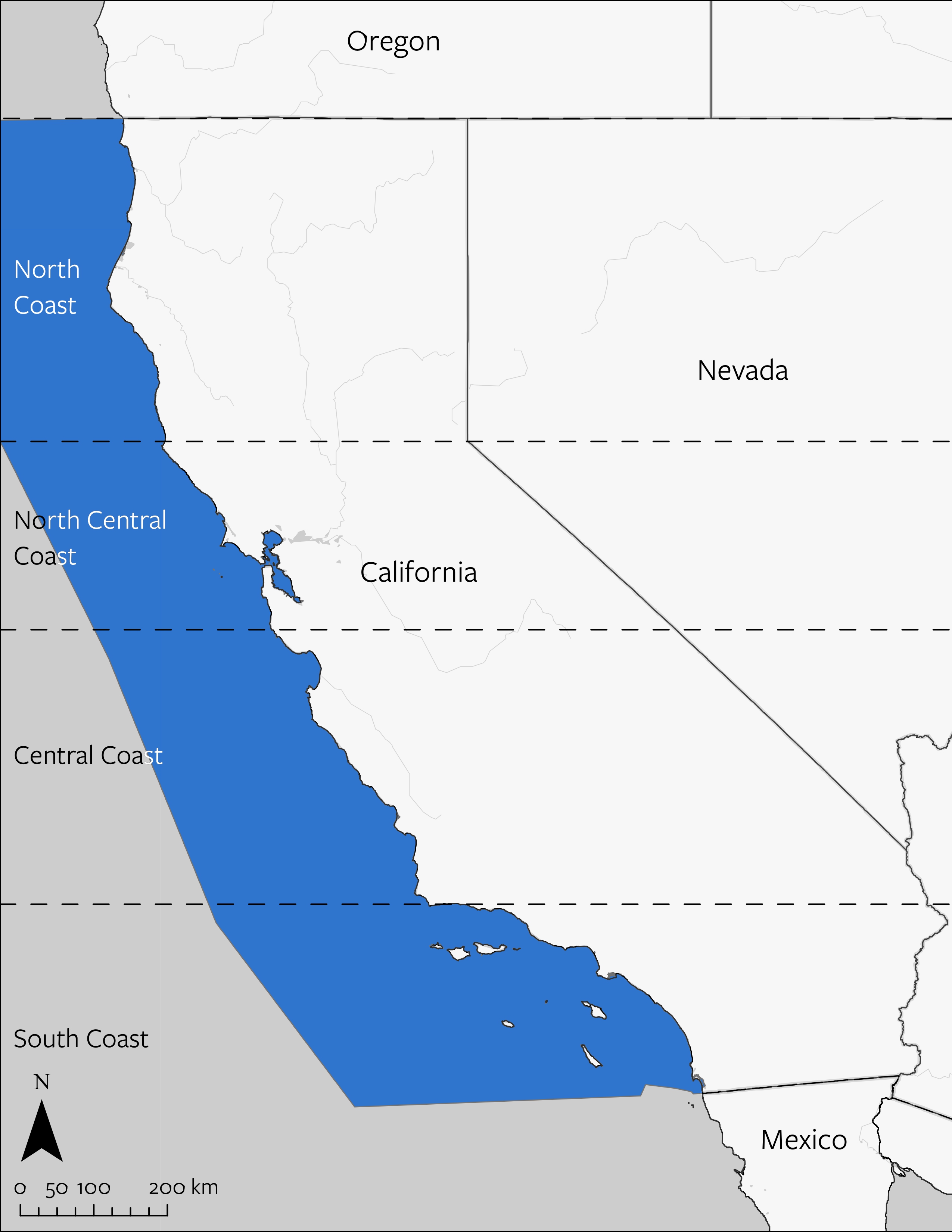
Reproductive Biology and Life History
These whales first reach reproductive maturity between 6 and 12 years old and can have calves once every 2 to 3 years thereafter. This interval between births is set by a gestation period of 12 to 13 months, followed by calves nursing for 7 months before weaning. Gray whales use the warm, shallow lagoons of Baja California, Mexico to nurse and raise their newborn calves. Calves are born between late December and early February. Gray whales have an average lifespan of 50 to 60 years, although some individuals have been known to live up to 70 years.
Ecology
Gray whales are bottom feeders, where they consume benthic invertebrates such as amphipods, tube worms, and mollusks. Their feeding technique involves diving to the ocean floor, rolling on their side, and sucking up sediment and food, which they filter through their baleen plates. This feeding behavior benefits the ecosystem because it resuspends nutrients in the water column and enriches the seafloor. An adult gray whale can consume as much as 1.3 tons of food per day.
Cultural and Historical Context
Gray whales were heavily hunted in the mid-1800s and early 1900s, primarily for their blubber, which was used to produce oil for lamps. This commercial hunting was particularly devastating in areas where gray whales raised their young, leading to a significant decline in their population and bringing them to the brink of extinction. Long before commercial whaling in California, the Chumash and Tongva tribes occasionally hunted and used gray whales – but such hunting was rare. These indigenous groups primarily revered whales as powerful ocean animals and often created art pieces depicting whales, indicating a cultural and spiritual connection rather than a focus on hunting them for subsistence.
Date modified: January 2025
Primary ThreatsPrimary Threats Conditions
Threats and Conservation Status
The commercial harvest of these whales was banned in 1947, and then in 1973, the species was one of the first to be listed as endangered through the U.S. Endangered Species Act. NOAA has conducted surveys to estimate gray whale abundance since 1967. Results from these surveys show that the eastern North Pacific gray whale population had recovered by the early 1990’s and it was subsequently removed from the U.S. Endangered Species List in 1994. Since then, the population has been, for the most part, relatively stable.
While the abundance of gray whales is sufficiently high with no immediate extinction risk, whales still warrant protection and conservation attention. Gray whales are particularly vulnerable to vessel strikes due to their migratory patterns along the U.S. West Coast, which coincide with heavy shipping traffic. Efforts to mitigate this risk include changing shipping lanes and implementing speed reduction zones to minimize collisions. Whales can be sensitive to ship noise as well, which appears to elevate their stress, with implications for reproduction. Further, gray whales are at risk from entanglement in commercial fishing gear, particularly from pot and trap fisheries, off California and throughout their range. There is also concern that climate change might reduce food availability and lead to starvation in gray whales. Notably, NOAA documented elevated numbers of whale strandings between 2019 and 2023 and initiated studies of this Unusual Mortality Event (UME). The gray whale population fell to about 14,500 in 2023 – the lowest abundance since the species was removed from the Endangered Species List in 1994. Fortunately, the most recent survey data from 2023-2024 indicated a strong recovery – with an increase in abundance to roughly 19,000 whales. This increase caused NOAA to suspend its special research into causes of the strandings.
The Gray Whale Census and Behavior Project is a prominent community science program based at the Point Vicente Interpretive Center in Rancho Palos Verdes, California. Volunteers, who are trained to identify and record marine mammals and their behaviors, contribute to understanding the seasonal usage of nearshore migratory paths and document trends over time. The project emphasizes calf sightings and records various behaviors, including breaching and feeding, as well as interactions with human activities like boating and fishing gear (e.g. entanglements). These data are shared with the National Marine Fisheries Service (NMFS) to aid in monitoring of the population.
Population Plots
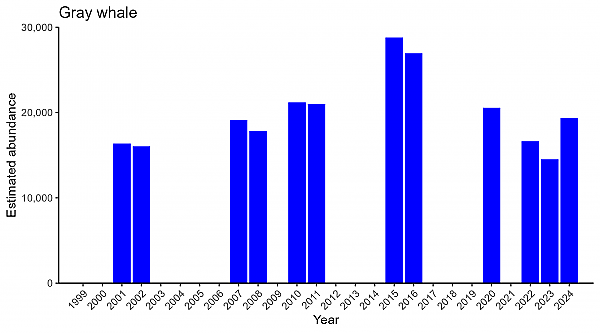
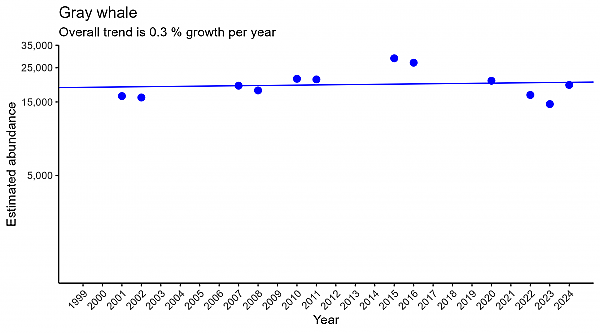
Data Source: The data were obtained from NOAA SWFSC, which oversees annual monitoring of the gray whale population along the California coastline. The most recent technical publication summarizing this data is https://swfsc-publications.fisheries.noaa.gov/publications/CR/2023/2023Eguchi.pdf.

